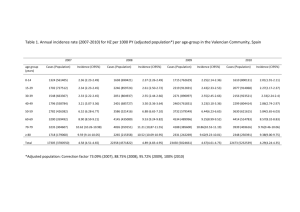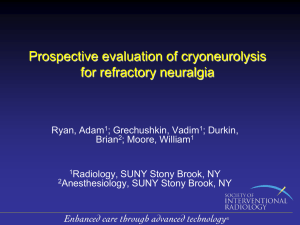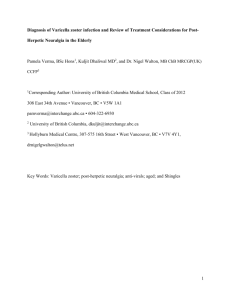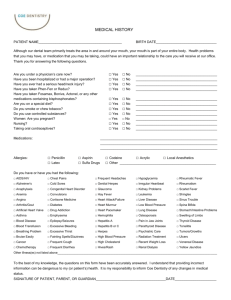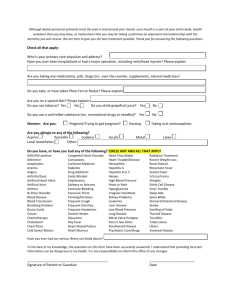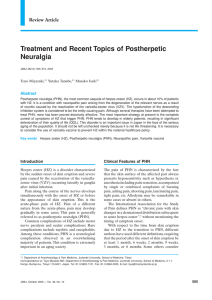Document 13214383
advertisement
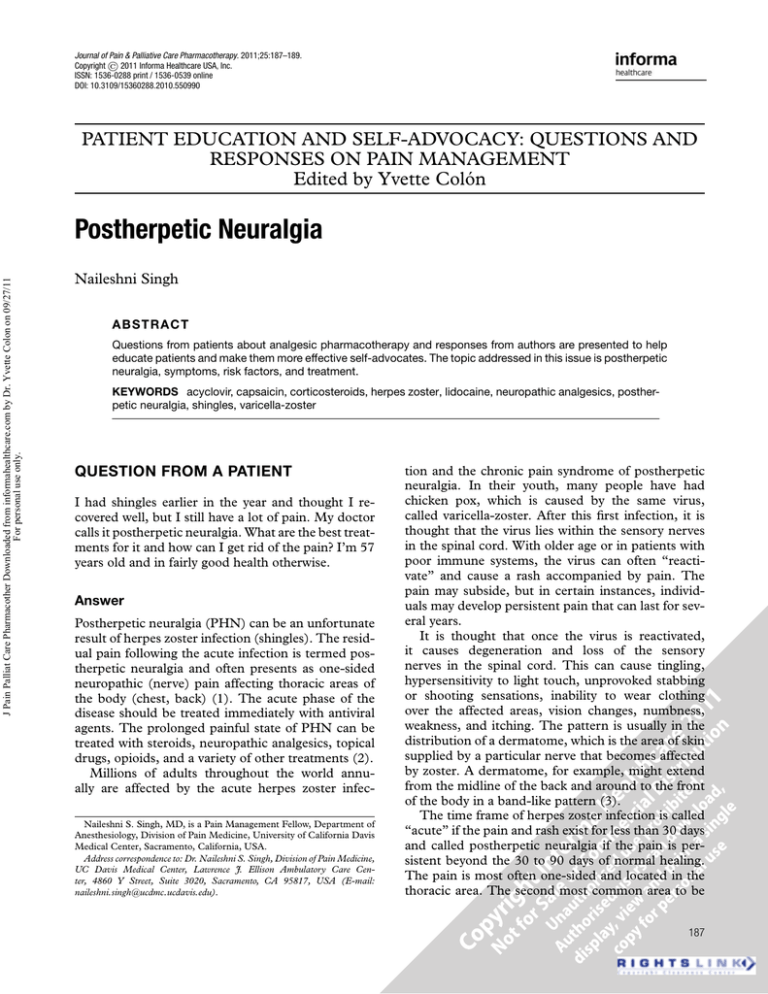
Journal of Pain & Palliative Care Pharmacotherapy. 2011;25:187–189. Copyright © 2011 Informa Healthcare USA, Inc. ISSN: 1536-0288 print / 1536-0539 online DOI: 10.3109/15360288.2010.550990 PATIENT EDUCATION AND SELF-ADVOCACY: QUESTIONS AND RESPONSES ON PAIN MANAGEMENT Edited by Yvette Colón J Pain Palliat Care Pharmacother Downloaded from informahealthcare.com by Dr. Yvette Colon on 09/27/11 For personal use only. Postherpetic Neuralgia Naileshni Singh A B STRA CT Questions from patients about analgesic pharmacotherapy and responses from authors are presented to help educate patients and make them more effective self-advocates. The topic addressed in this issue is postherpetic neuralgia, symptoms, risk factors, and treatment. KEYWORDS acyclovir, capsaicin, corticosteroids, herpes zoster, lidocaine, neuropathic analgesics, postherpetic neuralgia, shingles, varicella-zoster QUESTION FROM A PATIENT I had shingles earlier in the year and thought I recovered well, but I still have a lot of pain. My doctor calls it postherpetic neuralgia. What are the best treatments for it and how can I get rid of the pain? I’m 57 years old and in fairly good health otherwise. Answer Postherpetic neuralgia (PHN) can be an unfortunate result of herpes zoster infection (shingles). The residual pain following the acute infection is termed postherpetic neuralgia and often presents as one-sided neuropathic (nerve) pain affecting thoracic areas of the body (chest, back) (1). The acute phase of the disease should be treated immediately with antiviral agents. The prolonged painful state of PHN can be treated with steroids, neuropathic analgesics, topical drugs, opioids, and a variety of other treatments (2). Millions of adults throughout the world annually are affected by the acute herpes zoster infecNaileshni S. Singh, MD, is a Pain Management Fellow, Department of Anesthesiology, Division of Pain Medicine, University of California Davis Medical Center, Sacramento, California, USA. Address correspondence to: Dr. Naileshni S. Singh, Division of Pain Medicine, UC Davis Medical Center, Lawrence J. Ellison Ambulatory Care Center, 4860 Y Street, Suite 3020, Sacramento, CA 95817, USA (E-mail: naileshni.singh@ucdmc.ucdavis.edu). tion and the chronic pain syndrome of postherpetic neuralgia. In their youth, many people have had chicken pox, which is caused by the same virus, called varicella-zoster. After this first infection, it is thought that the virus lies within the sensory nerves in the spinal cord. With older age or in patients with poor immune systems, the virus can often “reactivate” and cause a rash accompanied by pain. The pain may subside, but in certain instances, individuals may develop persistent pain that can last for several years. It is thought that once the virus is reactivated, it causes degeneration and loss of the sensory nerves in the spinal cord. This can cause tingling, hypersensitivity to light touch, unprovoked stabbing or shooting sensations, inability to wear clothing over the affected areas, vision changes, numbness, weakness, and itching. The pattern is usually in the distribution of a dermatome, which is the area of skin supplied by a particular nerve that becomes affected by zoster. A dermatome, for example, might extend from the midline of the back and around to the front of the body in a band-like pattern (3). The time frame of herpes zoster infection is called “acute” if the pain and rash exist for less than 30 days and called postherpetic neuralgia if the pain is persistent beyond the 30 to 90 days of normal healing. The pain is most often one-sided and located in the thoracic area. The second most common area to be 187 J Pain Palliat Care Pharmacother Downloaded from informahealthcare.com by Dr. Yvette Colon on 09/27/11 For personal use only. 188 N. Singh affected is the face, particularly the area around the eyes. But zoster infections with long standing pain can occur in the limbs, abdomen, buttock areas, and even involve internal organs. Risk factors for PHN include older age (with age greater than 80 years old having a higher incidence), immunosuppression (such as in cancer patients), female gender, greater pain during the acute rash phase, and increased severity of the rash. People undergoing chemotherapy can often have reactivation of the latent virus because their immune system is unable to suppress the disease. Elders are a subpopulation who have less cellular-mediated immunity than younger people and so are more susceptible to viral infections. Vaccination to reduce the risk of shingles and its associated pain in people 60 years old or older has been recommended by the U.S. Centers for Disease Control and Prevention and many others (4, 5). Patients who have shingles rash or pain should see their primary care doctors early, within 72 hours of rash development, for treatment.4 The treatment for acute herpes zoster infection is an antiviral agent such as acyclovir, valacyclovir, famciclovir, or a newer drug called brivudin. Early treatment with a multiday course of antiviral medications has shown to decrease the acute pain episode, help with healing, stop skin lesion formation, and decrease the viral shedding potentially to stop the destruction of nerves. This is especially important in patients with zoster ophthalmicus, herpes zoster that affects the optic nerve that is responsible for eye sight. Early treatment can prevent complications such as vision loss. It is unclear, however, whether early antiviral treatment in the acute phase of herpes zoster infection prevents the development of PHN. There is evidence that corticosteroids such as prednisone taken orally within 72 hours of rash development may significantly reduce the acute pain phase. Sometimes steroids are combined with antiviral treatment to further help with healing and pain control. There is no proven sustained benefit, however, of either steroid alone or in combination with antiviral medications for the chronic phase of zoster infection. Many other medications have been studied in the treatment of PHN that seek to target the nerves thought to cause the pain. One of the most studied drug categories has been the tricyclic antidepressants (TCAs) such as amitriptyline, nortriptyline, and desipramine. They have been shown to be effective in decreasing the pain when early treatment is started. The mechanism of action is the release of neurotransmitters, such as norepinephrine, which pass nerve impulses from one neuron to the next. Not only is this class of medications useful in PHN, they are simple once-a-day dosing and relatively inexpensive. But side effects from this class of medications should be monitored, especially in older adults. Most side effects—drowsiness, nausea, constipation, increased heart rate, sweating, blurred vision, weakness—are minor, but abnormal heart rhythms, low blood pressure when standing, seizures, inability to urinate, mood changes, and confusion are also possible. Patients taking such medications should be assessed frequently for any of the aforementioned side effects.2 Another class of medications is the traditionally mild antiseizure medications, gabapentin and pregabalin. These agents are helpful for the neuropathic component of the pain experience, such as “electric,” “shooting,” or “burning” pain. Both these medications, however, can cause dizziness, drowsiness, gastrointestinal upset, headache, fatigue, swelling, fluid retention, and mood changes and like all other medications should be used carefully. Opioids such as hydrocodone, morphine, and oxycodone have long been used in both the acute and the chronic sequelae of herpetic infection. They work on opioid receptors in the spinal cord, brain, and tissues to relieve pain. The more common side effects are drowsiness, constipation, nausea, and itching. More serious complications include possible drug interactions, prolonged action in individuals with kidney disease, and depressed breathing.2 Their dosing, however, can be flexible because they are available in both short-acting and long-acting formulations. Several topical agents have been approved for use in postherpetic neuralgia. One is the lidocaine patch, which is embedded with a local anesthetic. Patients apply the patch to the painful areas for 12 hours and then take if off for 12 hours to prevent tolerance. The treatment is relatively benign, but can cause local skin irritation. Lidocaine also comes in ointment or cream form in a variety of strengths. Capsaicin is another cream used to alleviate nerve type pain. Moreover, 8% capsaicin patches have recently been approved for use in PHN. The patches must be applied by a health care professional in an office, procedure area, or other monitored setting. The patches are applied to the areas of sensitivity and are allowed to work for approximately 30 minutes with secure skin contact. The sensation from the patch can be unpleasant so patients receive sedation and pain control for the procedure itself. When application of the patch has concluded, the skin can look sunburned or irritated. Pain relief, however, can last up to 3 months and tolerance is not an issue. Both the lidocaine and capsaicin patches can be cut and formed to adhere to the affected areas Journal of Pain & Palliative Care Pharmacotherapy J Pain Palliat Care Pharmacother Downloaded from informahealthcare.com by Dr. Yvette Colon on 09/27/11 For personal use only. Journal of Pain & Palliative Care Pharmacotherapy of the skin. But although patients may use lidocaine patches daily, the application of the capsaicin patch is a more involved treatment done every few months. Novel and invasive treatments are also being studied for use in PHN. Botulinum toxin has been injected into the skin layers in patients with a variety of nerve type disorders including PHN, but the studies show mixed results. Some practitioners are also using nerve block treatments via epidural or intrathecal routes. The epidural space contains the spinal nerve roots and the thought is that medications deposited into that area using a needle may decrease the inflammation caused by the zoster virus. The intrathecal space is the area around the spinal cord and can be similarly accessed using a specialized needle. Epidural and intrathecal steroid injections have shown some promise, mostly in the acute phase of the pain syndrome. Implanted devices, called spinal cord stimulators, may modulate neuropathic pain using electric signals within the epidural space. They have been used for PHN, but there are limited data on their usefulness. Although there are many treatments for postherpetic neuralgia, it is difficult to predict which treatment is best for which type of patient (6). It is agreed that early treatment with antiviral agents will limit the C 2011 Informa Healthcare USA, Inc. 189 acute phase of the disease, but it is unclear whether that prevents the incidence of PHN. There is strong scientific evidence that TCAs, gabapentin, pregabalin, capsaicin, lidocaine patches, and opioids are helpful in PHN. REFERENCES [1] Opstelten W, McElhaney J, Weinberger B, Oaklander AL, Johnson RW. The impact of varicella zoster virus: chronic pain. J Clin Virol. 2010;48:S1, S8–S13. [2] Whitley RJ, Volpi A, McKendrick M, van Wijck A, Oaklander AL. Management of herpes zoster and post-herpetic neuralgia now and in the future. J Clin Virol. 2010;48:S1, S20–S28. [3] Baron R, Binder A, Wasner G. Neuropathic pain: diagnosis, pathophysiological mechanisms, and treatment. Lancet Neurol. 2010;9:807–819. [4] Centers for Disease Control and Prevention. Prevention of herpes zoster: recommendations of the advisory committee on immunization practices. MMWR Morb Mort Wkly Rep. 2008:57;1–30. Available at: http://www.cdc.gov/mmwr/ preview/mmwrhtml/rr5705a1.htm. Accessed December 14, 2010. [5] Hornberger, J, Robertus K. Cost-effectiveness of a vaccine to prevent herpes zoster and post herpetic neuralgia in older adults. Ann Intern Med. 2006;145:317–325. [6] Dworkin R, O’Connor AB, Bakonja M, et al. Pharmacologic management of neuropathic pain: evidence-based recommendations. Pain. 2007;132:237–251.
